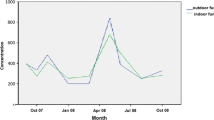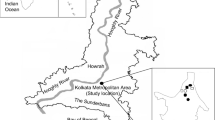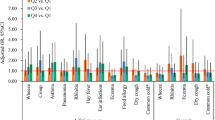Abstract
The purpose of this epidemiological study was to assess respiratory allergy in relation to the presence of indoor airborne fungi. The relationship between IgE-mediated respiratory allergy (skin test positivity) and the presence of fungi (CFU/m3) in the indoor environments of 104 subjects was assessed in a cross-sectional study by controlling for extraneous variables (age, gender, predisposition, asthma, rhinitis, skin positivity to ragweed and mite, and smoking). The qualitative and quantitative measurements of airborne seasonal fungi (Alternaria spp. andCladosporium spp.) and non-seasonal airborne fungi (Penicillium spp. andAspergillus spp.) were taken in the subjects’ indoor environments twice in a 2-year period by volumetric methods (Burkard Personal Sampler). There was a significant association between skin test positivity to seasonal fungi and to ragweed (Adj. OR=3.42, CI=1.76–6.66). There was no association between skin test positivity to seasonal fungi and asthma (Adj. OR=0.52, CI=0.28–0.98), but a significant association was found between skin test positivity to seasonal fungi and rhinitis (Adj. OR=5, CI=2.03–12.32). In a logistic regression analysis (maximum likelihood estimates—model A), no statistical association was found indoors between skin prick test positivity to seasonal fungi (Alternaria and/orCladosporium) and airborneAlternaria and/orCladosporium concentrations (Adj. OR=1.18, CI=0.66–2.07). There was a significant association between skin prick test positivity to seasonal fungi and to non-seasonal fungi (Adj. OR=12.81, CI=1.67–98.34). There was no association between asthma and airbornePenicillium concentrations (Adj. OR=1.86, CI=0.47–7.33) nor between rhinitis and airbornePenicillium concentrations (Adj. OR=0.18, CI=0.03–1.19). In another logistic regression analysis (maximum likelihood estimates — model B) using non-seasonal fungi (Aspergillus andPenicillium), no statistical association was found indoors between skin prick test positivity to non-seasonal fungi and airbornePenicillium concentrations (Adj. OR=0.33, CI=0.07–1.69). These findings suggest an association between rhinitis and seasonal fungi. In the rhinitis stratum, subjects who had skin test positivity to ragweed had a higher risk of being sensitive to seasonal airborne fungal allergens. Subjects with non-seasonal fungal allergy had a high relative risk if they were also allergic to seasonal fungi. There was no association between asthma and airborne fungi, as the epidemiological study (cross-sectional design), by definition, does not allow an etiological evaluation of chronic disease. This would require a longitudinal study, i.e. the measurement of repeated exposure as an independent variable (allergen) and repeated measurement as a function of the disease as outcome in humans as a dependent variable.
Similar content being viewed by others
References
Al-Doory, Y. and Domson, J. (1984) Mold Allergy. Lea and Febiger, Philadephia, PA, pp. 35, 67, 110–125, 147.
Basset et al. (1978) An Atlas of Airborne Pollen Grain and Common Fungus Spores of Canada. Agriculture Canada, 321 pp.
Botton, B. et al. (1990) Moisissures utiles et nuisibles. Importance industrielle. Collection biotechnologies. Mason, Paris, 512 pp.
Bousquet, J. (1990) Specific Immunotherapy in Asthma Postgraduate Course. J. Allergy Clin. Immunol. 86(3), part 1, 292–301.
Bruce, C. and Norman, P. (1977) The role of ragweed pollen in autumnal asthma. J. Allergy Clin. Immunol. 59(6), 449–459.
Burge, H. (1992) Fungal immunochemistry. Syllabus Allergy and Immunology. American College of Allergy and Immunology, 14–18. November, Chicago, pp. 235–238.
Chapman, M. (1992) Immunochemistry ofAspergillus fumigatus allergens. Syllabus Allergy and Immunology. American College of Allergy and Immunology, 14–18 November, Chicago, pp. 243–246.
Dreborg, S. and Agrell, B. (1986) A double-blind, multicenter immunotherapy trial in children using a purified and standardizedCladosporium herbarum preparation. 1. Clinical results. Allergy 41(2), 131–140.
Gayers, J. (1986) Trends in asthma and hay fever in general practice in the United Kingdom 1976–1983. Thorax 41, 111–116.
Horst, M., Hejjaovi, A., Horst, V., Michel, B. and Bousquet, J. (1990). Double-blind, placebo controlled rush immunotherapy with a standardizedAlternaria extract. J. Allergy Clin. Immunol. 85, 460–472.
Hosmer, D. and Lemeshow, S. (1989) Applied Logistic Regression. Wiley, New York, pp. 106–133.
Kleinbaum, D., Kupper, L. and Morgenstern, H. (1982) Epidemiologic Research. Van Nostrand Reinhold, New York, pp. 403–409, 420.
Lehrer et al. (1982) Skin reactivity and IgE antibodies to basidiomycete extract. J. Allergy Clin. Immunol. 69(2), 97.
Mailling, H.J. and Dreborg, S. (1986) Diagnosis and immunotherapy of molds allergy. Clinical efficacy and side effects of immunotherapy withCladosporium herbarum. Allergy 41(7), 507–519.
Metzger, W.J. and Donnelly, B.A. (1983) Modification of late asthmatic responses (LAR) during immunotherapy forAlternaria-induced asthma. J. Allergy Clin. Immunol. 71, 119, Abstr.
Miettenin, O. (1974) Confounding and effect modification. Am. J. Epidemiol. 100, 350–353.
Ohman, J.L. (1989) Continuing medical education. J. Allergy Clin. Immunol. 84(2), 133–134.
Packe, G.E. et al. (1985) Asthma outbreak during a thunderstorm. Lancet 27, 199–203.
Platts-Mills, A.E.T. (1989) Measurement of airborne allergen using immunoassays. Immunol Allergy Clin. North Am. 9(2), 269–279.
Prahl, P. (1992) Reduction of indoor airborne molds spores. Allergy 47, 362–365.
Rosenwasser, J.L. (1991) Molecular biology of allergen characterization. Post graduate Education Course Syllabus. American Academy of Allergy and Immunology, pp. 1661–1667.
Rothman, K. (1986) Modern Epidemiology: Little, Brown, pp. 140–147, 226–289.
Salvaggio, J. and Lopez, M. (1976) Allergenicity and immunogenicity of basidiomycetes. J. Allergy Clin. Immunol. 57, 480.
Santilli, J. et al. (1990) Individual patterns of immediate skin reactivity to molds extracts. Ann. Allergy 65, 454–458.
Smith, E. Grant (1990) An Illustrated Identification Manual for Air Samplers. San Antonio, Texas.
Su, H.J. et al. (1992) Examination of fungi in domestic interiors by using factor analysis: correlations and associations with home factors. Appl. Environ. Microbiol. 58(1), 181–186.
Tseng, R.Y.M. et al. (1992) Particulate air pollution and hospitalization for asthma. Ann. Allergy 68, 425–432.
Tuchinda, M., Habananda, S., Vareenil, J., Srimaruta, N. and Piromrat, K. (1987) Asthma in Thai children: a study of 2000 cases. Ann. Allergy 59, 207–211.
Verhoeff, P. et al. (1992) Presence of viable mold propagules in indoor air in relation to house damp and outdoor air. Allergy 47, 83–91.
Vijay, H.M. et al. (1979) Studies onAlternaria allergens. Isolation of the allergens fromAlternaria tenuis andAlternaria solani. Int. Arch. Allergy Appl. Immunol. 60, 229.
Vijay, H.M. et al. (1991) Cross-reactivity of extracts ofCladosporium species andAlternaria alternata. J. Allergy Clin. Immunol. 87(1), part 2, suppl.
Author information
Authors and Affiliations
Rights and permissions
About this article
Cite this article
Barkova, T., Comtois, P., Chad, Z. et al. Indoor airborne fungi as risk factors in IgE-mediated respiratory allergy. Aerobiologia 11, 119–128 (1995). https://doi.org/10.1007/BF02738277
Received:
Accepted:
Issue Date:
DOI: https://doi.org/10.1007/BF02738277




